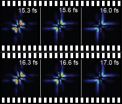(Press-News.org) Researchers from North Carolina State University have found a way of binding peptides to the surface of gallium nitride (GaN) in a way that keeps the peptides stable even when exposed to water and radiation. The discovery moves researchers one step closer to developing a new range of biosensors for use in medical and biological research applications.
GaN is a biocompatible material that fluoresces, or lights up, when exposed to radiation. Researchers are interested in taking advantage of this characteristic to make biosensors that can sense specific molecules, or "analytes," in a biological environment.
To make a GaN biosensor, the GaN is coated with peptides - chains of amino acids that are chemically bound to the surface of the material. These peptides would respond to the presence of specific analytes by binding with the molecules.
The idea is that, when exposed to radiation, the intensity of the light emitted by the GaN would change, depending on the number of analytes bound to the peptides on the surface. This would allow researchers and clinicians to monitor the presence of different molecules in a biological system. But it's not quite that simple.
"A key challenge in developing GaN biosensors has been finding a technique to bind the peptides to the GaN surface in a way that keeps the peptides stable when exposed to aqueous environments - like a cell - and to radiation," says Dr. Albena Ivanisevic, senior author of a paper on the work and an associate professor of materials science and engineering at NC State. "Now we have done that."
"We used a two-step process to bind the peptides," explains Nora Berg, a Ph.D. student at NC State and lead author of the paper. "First we used a combination of phosphoric and phosphonic acids to etch the GaN and create a stable 'cap' on the surface. We were then able to attach the relevant peptides to the phosphonic acids in the cap."
To determine the stability of the peptides, the researchers placed the coated GaN in an aqueous solution and then placed the solution in a "phantom material" that mimics animal tissue. The GaN, solution and phantom material were then exposed to high levels of radiation, beyond what would be expected in a clinical setting. The material was then evaluated to see if there was any degradation of the peptides or of the GaN itself.
"The peptides remained on the surface," Berg says. "The aqueous solution caused an oxide layer to form on the surface but there is no indication that this would affect the functionality of the peptides."
"Now that we've shown that this approach allows us to create functional, stable peptide coatings on this material, we're moving forward to develop a particle configuration - which would be injectable," Ivanisevic says. "This will open the door to in vitro testing of the material's sensing capabilities."
The paper, "Surface Characterization of Gallium Nitride Modified with Peptides Before and After Exposure to Ionizing Radiation in Solution," was published online Dec. 5 in the journal Langmuir. The paper was co-authored by Dr. Michael Nolan, an assistant professor of radiation biology and oncology at NC State, and Dr. Tania Paskova, a research professor of electrical engineering at NC State.
INFORMATION:
This news release is available in German.
Physicists are continuously advancing the control they can exert over matter. A German-Spanish team working with researchers from the Max Planck Institute for Nuclear Physics in Heidelberg has now become the first to image the motion of the two electrons in a helium atom and even to control this electronic partner dance. The scientists are succeeding in this task with the aid of different laser pulses which they timed very accurately with respect to each other. They employed a combination of visible flashes of light and ...
Trophoblasts, cells that form an outer layer around a fertilized egg and develop into the major part of the placenta, have now been shown to respond to inflammatory danger signals, researchers from Norwegian University of Science and Technology (NTNU) found in a recent study published in Journal of Reproductive Immunology December 2014.
The researchers said their findings were an important step in understanding how inflammatory responses in the placenta can contribute to the development of pregnancy disorders such as preeclampsia.
The trophoblast inflammatory response ...
This news release is available in German.
Puebla del Guzman (Andalusia) / Magdeburg. Being part of the mining area Herrerias in Andalusia, deep waters of Pit Lake Guadiana show extremely high concentration of dissolved carbon dioxide (CO2). In the case of a spontaneous ebullition, human beings close-by would be jeopardized. To demonstrate the danger and the possible solution, scientists of the Spanish Institute of Geology and Mining, the University of the Basque Country (UPV/EHU, Bilbao) and the Helmholtz Centre for Environmental Research (UFZ) constructed a pilot ...
Chlorine is a common disinfectant that is used to kill bacteria, for example in swimming pools and drinking water supplies. Our immune system also produces chlorine, which causes proteins in bacteria to lose their natural folding. These unfolded proteins then begin to clump and lose their function. RUB researchers headed by Prof Dr Lars Leichert have discovered a protein in the intestinal bacterium E. coli that protects bacteria from chlorine. In the presence of chlorine, it tightly bonds with other proteins, thus preventing them from coagulating. Once the danger has passed, ...
This news release is available in German. A team of scientists headed by Dr. Florian Bassermann at the III. Medizinische Klinik, TUM Klinikum rechts der Isar, has been investigating mantle cell lymphoma, a subgroup of non-Hodgkin's lymphoma, which, despite new therapies, has poor patient survival rates. "Programmed cell death no longer functions in many lymphoma cells. This causes them to multiply uncontrollably. We urgently need to find out what's going wrong in these cells in order to find new treatment therapies," explains Bassermann.
The scientists started analyzing ...
A new study shows that many patients infected with the hepatitis C virus (HCV) are lost during different stages of health care to manage the disease. This real-life' view of the HCV patient care continuum in a major U.S. urban area is published in Hepatology, a journal of the American Association for the Study of Liver Diseases, and highlights the importance of generating awareness among clinicians and at-risk groups about appropriate HCV testing, referral, support and care.
Despite efforts to manage HCV, it is one of the most prevalent diseases with up to 150 million ...
Hydrogen peroxide (H2O2) is a strong oxidizer and is used as a bleaching agent for hair and teeth, and as a wound disinfectant. In addition, H2O2 also forms in the body, for example as a metabolic product of cellular respiration. It belongs to a group of chemicals called reactive oxygen species (ROS), which scientists suspect to have a damaging effect on cells and their components. For example, they are believed to play a role in carcinogenesis, degenerative diseases, and even aging. Body cells contain large quantities of enzymes called peroxiredoxins that degrade H2O2 ...
Research that provides a new understanding as to why ferrets are similar to humans is set to have major implications for the development of novel drugs and treatment strategies.
Published in the prestigious journal Nature Communications, the research is a collaboration between Professor Michael Jennings and other researchers from the Institute for Glycomics, Griffith University and collaborators at the University of Queensland and the University of Adelaide.
The team has shown for the first time that ferrets share a mutation that was previously thought to be unique ...
ANN ARBOR--In a development that could lead to a deeper understanding of cancer and better early-stage treatment of the disease, University of Michigan researchers have devised a reliable way to grow a certain type of cancer cells from patients outside the body for study.
The new technique is more than three times as effective as previous methods.
Researchers say it's a major step forward in the study of circulating tumor cells, which are shed from tumors and circulate through the blood of cancer patients. They're believed to cause metastasis, the spread of cancer ...
SAN FRANCISCO--The Greenland Ice Sheet is ready for its close-up.
The highest-resolution satellite images ever taken of that region are making their debut. And while each individual pixel represents only one moment in time, taken together they show the ice sheet as a kind of living body--flowing, crumbling and melting out to sea.
The Ohio State University has partnered with the Polar Geospatial Center at the University of Minnesota to turn images captured by DigitalGlobe's Worldview-1 and 2 satellites into publicly available elevation maps that researchers can use to ...



